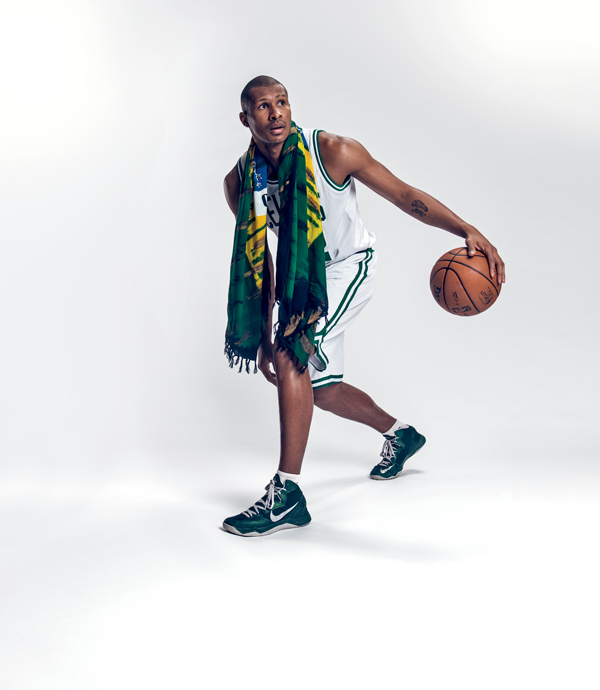Goooaaaal!—Leandro Barbosa and the Global Future of Basketball
Editor’s Note: The subject of this story, the Celtics’ Leandro Barbosa, was traded to the Washington Wizards on February 21, 2013.

Photo by JJ Miller
If I’d never before laid eyes on Celtics guard Leandro Barbosa, it wouldn’t have been difficult to pick out the lone Brazilian on the court when I watched the team practice recently in Waltham. At one end, Jeff Green was dropping a fusillade of free throws. At the other, Jason Terry was planted behind the arc, fine-tuning his three-pointer. Nearby, on a side hoop, another player was working on lay-ups…with his feet. He deftly shifted the ball from one foot to the other, kicked it up in the air and off his chest, and launched it off the backboard for an easy basket. When Barbosa sat down to talk, I had to compliment him on his fancy footwork.
“Oh, thanks. Just warming up, you know.”
The 30-year-old Barbosa donned the green jersey this season after nine years in the NBA—seven of them with the Phoenix Suns, and the rest with the Toronto Raptors and the Indiana Pacers. Early on with the Suns, he was considered one of the fastest players in the NBA, earning him the nickname “The Brazilian Blur,” and in 2007 the Sixth Man of the Year Award, for producing 18 points per game off the bench. Although he saw little court time in the first half of this season, he became a solid contributor off the bench after Rajon Rondo’s season-ending ACL injury in January left a gaping hole to fill in the Celtics backcourt—until, that is, his season came to an end, after he tore his left ACL against the Charlotte Bobcats on February 11.
Barbosa wasn’t the only Brazilian added to the Celtics roster this year. Fab Melo, the 22-year-old 7-footer from Syracuse University, was drafted as the 22nd pick, becoming the fifth Brazilian currently playing in the NBA—alongside Barbosa, Tiago Splitter, Nene Hilario, and Anderson Varejão. When I asked Barbosa how Brazil, a fanatical soccer nation, became an exporter of NBA-level basketball talent, he just smiled and shrugged his shoulders, appearing to be as amazed as anyone by the turn of events that led him to the Celtics. “Where I grew up,” he said, “hardly anyone played basketball. Soccer was the game. If you didn’t play soccer there was maybe something wrong with you.”
As deep as his passion runs for his chosen sport, soccer remains Barbosa’s first love—part of his national DNA. “I never gave up soccer. If I weren’t playing basketball, I’d be playing soccer,” he says. And he’s convinced that his soccer roots have served him well in the NBA. “With soccer, you have to have quick feet, control, and balance. At the same time, you have to have vision for the field. So when I get the ball now, it’s easier for me to dribble and see the whole court.”
Barbosa grew up poor in the shanty towns, or favelas, of São Paulo, Brazil’s largest city. Like most South American players, he was dribbling with his feet long before he ever mastered it with his hands. “When I was a kid—starting when I was, like, three—we’d play soccer barefoot on the street. We’d just set up two rocks on each side to form a goal. That’s how I got quick on my feet,” he says. Melo, eight years Barbosa’s junior, got a similar start. Born and raised in Juiz de Fora, an industrial city just north of Rio de Janeiro, he played soccer until he was in ninth grade. That’s when his coach looked at his size-18 cleats and told him it was time to trade them in for some high-tops.
In Brazil, as in most of the world, soccer has long been the number-one sport—the “people’s game,” as it’s often called. An English creation with deep medieval roots, soccer went global in the late-19th century, as the English took it to their colonies around the world. Nation after nation made the game its own. Basketball, a Johnny-come-lately sport invented (here in Massachusetts) in a YMCA gym in 1891, first reached Brazil and many other countries just a few years after soccer. With just a small but growing following in the U.S., and without the force of empire behind it, however, basketball couldn’t challenge soccer’s emergence as the global game. So it’s no surprise that when Barbosa was playing in the streets of São Paulo in the late 1980s, basketball was barely on his radar.
It was his older brother, Arturo, a first sergeant and paratrooper in the Brazilian military, who first introduced him to the sport that would change his life. Arturo was at the time a passable bench player in a local basketball club. Watching his younger brother’s speed and footwork playing soccer, he detected a raw athletic talent that he himself lacked. So, with an eye toward financial opportunities for the family, he shifted his energies toward training the young Barbosa to make the unlikely journey to the NBA. “There weren’t a lot of basketball courts around,” Barbosa recalls, “so my brother attached an old rim to the wall in the street where we lived. The rim was smaller than regulation, and the net was made of chain metal. It was good training for me playing on that smaller rim, because after that, whenever I played on regulation size, I’d make every shot.”
Sergeant Barbosa’s methods were unorthodox, to say the least. For ball-handling drills, he’d make his younger brother dribble a tennis ball through and around a series of folding chairs. To make sure his brother got things just right, Arturo often wielded a stick. “He would have me hold out my hands and he would hold the stick,” Barbosa told an interviewer for the Arizona Republic back in 2003. “It was for agility. He’d move the stick, and if the hands didn’t move, that stick would hit really hard.” Harsh as these tactics were (they left a permanent scar on his hand), Barbosa attributes his success to his brother’s singular focus and discipline. “I suffered a lot in his hands,” Barbosa said, “but thanks to him I’m here.”


